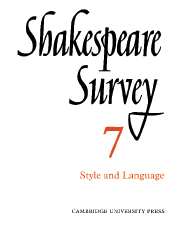Book contents
- Frontmatter
- Fifty Years of the Criticism of Shakespeare’s Style: A Retrospect
- Shakespeare and Elizabethan English
- The Poet and the Player
- Shakespeare’s Orthography in Venus and Adonis and Some Early Quartos
- The New Way with Shakespeare’s Texts: An Introduction for Lay Readers. I. The Foundations
- The Red Bull Company and the Importunate Widow
- Vaulting the Rails
- Shakespeare and the Acting of Edward Alleyn
- The Birmingham Shakespeare Memorial Library
- Shakespeare’s Italy
- International Notes
- Shakespeare Productions in the United Kingdom: 1952
- Acting Shakespeare: Modern Tendencies in Playing and Production
- The Year's Contributions to Shakespearian Study 1 Critical Studies
- 2 Shakespeare’s Life, Times and Stage
- 3 Textual Studies
- Books Received
- Index
- Plate Section
Fifty Years of the Criticism of Shakespeare’s Style: A Retrospect
Published online by Cambridge University Press: 28 March 2007
- Frontmatter
- Fifty Years of the Criticism of Shakespeare’s Style: A Retrospect
- Shakespeare and Elizabethan English
- The Poet and the Player
- Shakespeare’s Orthography in Venus and Adonis and Some Early Quartos
- The New Way with Shakespeare’s Texts: An Introduction for Lay Readers. I. The Foundations
- The Red Bull Company and the Importunate Widow
- Vaulting the Rails
- Shakespeare and the Acting of Edward Alleyn
- The Birmingham Shakespeare Memorial Library
- Shakespeare’s Italy
- International Notes
- Shakespeare Productions in the United Kingdom: 1952
- Acting Shakespeare: Modern Tendencies in Playing and Production
- The Year's Contributions to Shakespearian Study 1 Critical Studies
- 2 Shakespeare’s Life, Times and Stage
- 3 Textual Studies
- Books Received
- Index
- Plate Section
Summary
There is no question relating to Shakespeare as a writer which does not involve his style. His only art was that of dramatic speech: his thoughts and beliefs are known only through his art: he left no equivalent of Milton’s De Doctrina or Boswell’s private papers. Yet on this central problem comparatively little has been written. It is too vast and intimidating; critics evade it for topics of characterization, theatrical conditions, philosophic implications; or they nibble at a corner—imagery, punctuation, Euphuism. In Ebisch and Schücking’s Shakespeare Bibliography (1930), nineteen pages out of nearly three hundred suffice for Language, Vocabulary, Prosody and Style; C. H. Herford’s little sketch (1925) does not include the subject, ‘Mind, Art and Personality’ being his nearest approach. The earliest definitions of Shakespeare’s style—Webster’s “right happy and copious industry”, Heminge and Condell’s “easiness”, the tributes of Jonson, Milton and Dryden have not since been matched in comprehensiveness and assurance. Restoration poets showed their views of Shakespeare’s style by the freedom with which they ‘improved’ him; the adaptations of Rowe and Otway, Davenant and Tate and of Dryden himself are documents in the history of criticism (see Hazelton Spencer, Shakespeare Improved, 1927). Many editors of the eighteenth century allowed themselves almost comparable liberty of emendation, erasing such unheroic nouns as “hats”, “fishes” or “blanket”.
- Type
- Chapter
- Information
- Shakespeare Survey , pp. 1 - 11Publisher: Cambridge University PressPrint publication year: 1954

